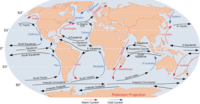
Photo from wikipedia
We investigate changes in the Arctic Ocean energy budget simulated by 26 general circulation models from the Coupled Model Intercomparison Project Phase 5 framework. Our goal is to understand whether… Click to show full abstract
We investigate changes in the Arctic Ocean energy budget simulated by 26 general circulation models from the Coupled Model Intercomparison Project Phase 5 framework. Our goal is to understand whether the Arctic Ocean warming between 1961 and 2099 is primarily driven by changes in the net atmospheric surface flux or by changes in the meridional oceanic heat flux. We find that the simulated Arctic Ocean warming is driven by positive anomalies in the net atmospheric surface flux in 11 models, by positive anomalies in the meridional oceanic heat flux in 11 models, and by positive anomalies in both energy fluxes in four models. The different behaviors are mainly characterized by the different changes in meridional oceanic heat flux that lead to different changes in the turbulent heat loss to the atmosphere. The multimodel ensemble mean is hence not representative of a consensus across the models in Arctic climate projections.
Journal Title: Geophysical Research Letters
Year Published: 2017
Link to full text (if available)
Share on Social Media: Sign Up to like & get
recommendations!